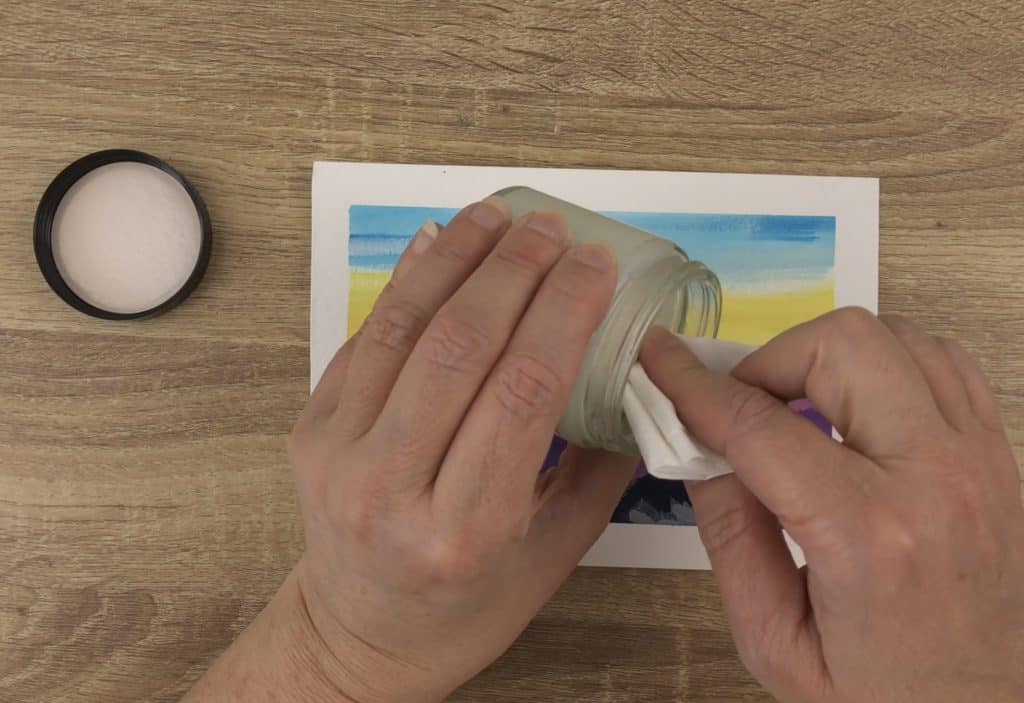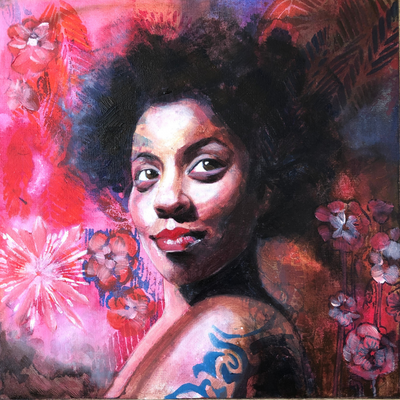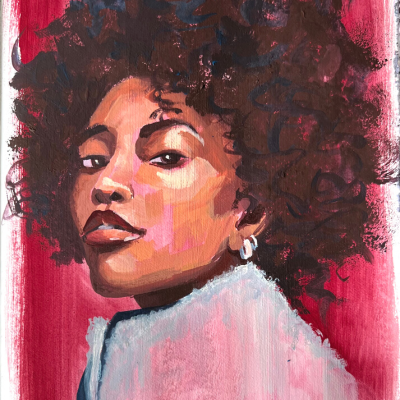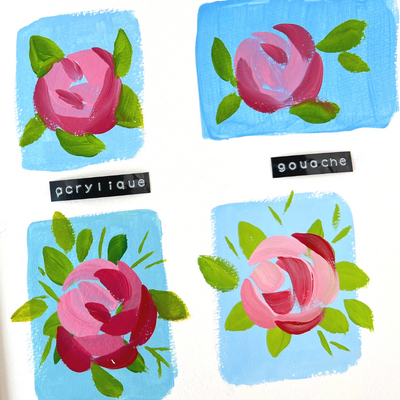How to choose between gouache and acrylic
Gouache and acrylic paint are both:
- opaque medium
- water-based
- washable with water
- available in a large range of bright colors
Let’s compare them to choose between gouache and acrylic.
Composition
Acrylic paint has acrylic polymer as its binder, forming a film after the water has evaporated, kind of magic if you think about it. In the tube, it’s fresh and creamy, and once on the paper, it’s solid and waterproof. A tube of acrylic paint also contains plasticizers, silicone oils, defoamers, and stabilizers, exposing painters and the environment to chemicals.
The gouache binder is often Arabic gum, as in watercolor, and it’s a binder that allows the paint to be reactivated once dry.

Water resistance
Once acrylic paint is dry, it’s forever! Either on paper, on the palette, or inside the brushes. So you’d better be quick when cleaning your stuff.
Gouache can be reactivated once dry. You could say that gouache is never dry, as you can still add water and move the pigments on the paper. Suitable for fixing mistakes on the paper, for example, or cleaning your brushes and palette. But it’s also fragile, as any drop of water on the finished painting will leave a mark.
Dust resistance
The acrylic binder makes a protective surface on the paper. You can hang your acrylic painting in a frame without glass, which will be okay for a long time. You can even remove the dust on the painting by swiping a cloth on it.
For gouache, the matte finish and the lack of polymer in the mix make the surface subject to hold dust. You’d better frame your art behind glass to protect it. Or you can varnish your gouache painting, but it’s more to protect your artwork from humidity than dust, as the sticky surface of the varnish will hold dust.

Application
With acrylic paint, you can get different thicknesses and add medium and gels for more texture. It can go from thin and transparent (although you can’t dilute acrylic to watercolor, too much water and the pigments will separate from each other) to impasto, with solid brushstrokes. Various tools can be used for applying acrylic paint: brushes of all kinds, spatulas, plastic cards, wedges… and even your fingers!
You can dilute the gouache with water until you get watercolor. The consistency can be thick, but too much and the paint will crackle. You have to control the water you use to get the right consistency.
Layering
There is no limit to the number of layers you can apply with acrylic, and you could even layer a dozen coats, and it will still be fine. However, I wonder why you would do this!
With gouache, there is a limit for layering, depending on the thickness of the coats. Pigments will eventually merge, and the paper will take less paint. In my experience, four or five layers are a maximum.

Surface sheen
The classic acrylic is between shiny and glossy, depending on the brand. You can get a matte finish, too, and it’s called Acryla Gouache. A bit confusing as this is acrylic with a matte finish, not gouache!
Gouache has a matte finish with a velvet touch. It’s great to take pictures of the finished painting as you won’t have any reflections. You can apply varnish on top to get a shiny effect, though.
Substrates to paint on
You can paint with acrylic on virtually anything: paper, cardboard, wood, glass, and metal… it’s endless. Sometimes you’ll need to add some preparation to the surface for the paint to adhere.
You can apply gouache to papers of all kinds: drawing paper, watercolor paper, kraft, colored papers, and cardboard… You can even directly paint on wood or canvas with gouache.
Blending
Depending on the brands and the paint drying time, it can be challenging to blend with acrylic. Some paints dry so fast that you can hardly have time to blend, and adding a medium may slow the drying process.
On the contrary, blending gouache is easy if you have enough consistency to paint with. You can learn more about gouache blending here.

Cleaning
Cleaning acrylic after your painting session is crucial; you need to do this as soon as possible, as it may ruin your brushes. If you let the paint sit inside the brush, you will risk damaging the hair to get it back. Cleaning palettes is very easy. You can let the paint dry and remove the film in large pieces or spray water to soften it and scrape the paint to remove it. It’s easier to do with a hard surface palette.
To clean gouache on brushes or palettes, your skin, or clothes, use tap water and a bit of soap, even if the paint is dry. Dry gouache will never damage your brushes.
Summary
| Gouache | Acrylic | |
| Composition | Pigments, chalk, and Arabic gum mainly, very few chemicals. | A lot of chemicals inside. |
| Layering | A limited number of layers. | It can be layered forever. |
| Blending | Easy to blend. | Quite challenging to blend without medium. |
| Sheen | Matte finish. | Matte, shiny, satin… |
| Cleaning | Water reactivated, so easy to clean. | You need to clean it at once. |
| Best for | Studio, Plein Air, Studies | Studio, Large canvases |
Conclusion
So how to choose between gouache and acrylic paint is very personal, depending on your style, where you paint, if you can let your palette for a while before cleaning it, if you like blending a lot, if you want textures, if you’re sensitive to chemicals…
I’ll let you choose the one you prefer. My love goes for gouache.









